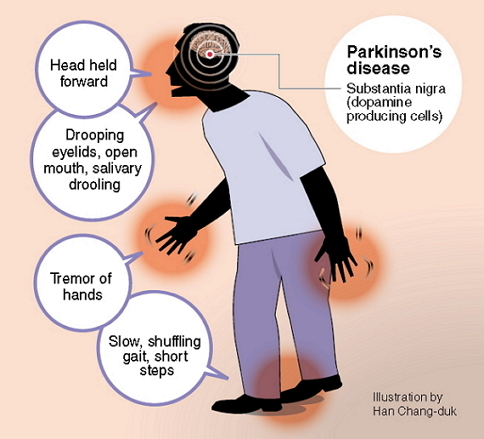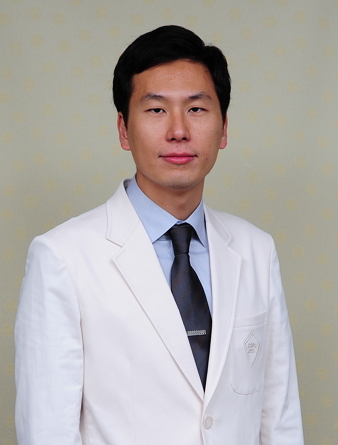Parkinson’s disease is a degenerative disorder of the central nervous system due to the death of dopamine-generating cells in the substantia nigra of the brain. While tremor at rest, bradykinesia, muscle stiffness and postural reflex impairment are the four most common symptoms of Parkinson’s disease, the disease commonly causes various other symptoms.
Parkinson’s disease is primarily diagnosed from the medical history and symptoms of the patient. Not everyone with certain suspected symptoms of Parkinson’s disease have it. Therefore, it is very important to be diagnosed by physicians, because the patient may or may not have all the major symptoms of Parkinson’s disease.
Tremor at rest
Tremor is the most apparent and best-known symptom of Parkinson’s disease. A tremor appears in various body parts including the hand, leg and chin. However, about 30 percent of patients do not experience tremors. The characteristic of tremor in Parkinson’s disease is “tremor at rest,” which appears when the patient is in resting position, and it gets better when the patient moves the body. Consequently, tremor may not cause any real-life inconvenience. However, it is the most stressful symptom due to the attention it attracts.
Bradykinesia/muscle rigidity
Bradykinesia is the slowness of movement, rigidity of muscles, and stiffness and resistance to movement caused by increased muscle tone. Unlike the noticeable tremor, bradykinesia or muscle rigidity slowly develops and progresses. Consequently, it could be seen as tiredness of the limbs or as a symptom caused by the aging process. A person could have Parkinson’s disease if he or she has difficulty walking compared to other people of the same age, ordinary tasks such as cooking are done slowly, and his or her face looks scary due to a fixed vacant facial expression. The patient often tends to have less movement in the severely stiff muscles, Parkinson’s disease symptoms that may be mistaken for a stroke or frozen shoulders.

Difficulty walking/Postural reflex impairment
A patient with Parkinson’s disease is likely to have reduced arm swing on one side when walking, take small steps, and bend forward slightly at the waist. Patients often show a freezing of the gait such as shuffling with one’s feet close together and having trouble with turning around. Patients frequently fall when postural reflexes have decreased. Moreover, patients with osteoporosis should be fully alert to the possibility of bone fractures. Since it is rare in the initial stage of the disease, it may not cause a big problem at first. However, as the disease develops gradually, the quality of the patient’s life may be largely impacted by bone fractures and limitation on activity.
Non-motor symptoms
While the symptoms that are introduced are motor symptoms related to movement, various non-motor symptoms in Parkinson’s disease have recently recognized. Some non-motor symptoms such as difficulty smelling or sleeping, constipation and depression may appear prior to the motor symptoms. Also, various non-motor symptoms such as anxiety, apathy, REM sleep behavior disorder, autonomic nervous system disorder, cognitive impairment, pain and weight loss may be seen in Parkinson’s disease patients.
Treatment
The major concept of treating Parkinson’s disease is controlling the symptoms. Similar to diabetic patients having medication to lower the blood glucose level rather than to treat diabetes itself, a patient with Parkinson’s disease may control one’s symptoms through medicine treatment. Since Parkinson’s disease gradually progresses, adequate medicial treatment may allow the patient to maintain the same daily life. If the symptoms are not controlled with medication, surgical treatment such as deep brain stimulation may help to relieve the symptoms.
The major concept of the medicine treatment of Parkinson’s disease is the supply of dopamine. As medications with various biological activities have been developed, medication for Parkinson’s disease patients is complex and patients commonly take many different kinds of medication. In the long term, the amount of medication would increase as the disease develops. Accordingly, taking various medications with different functions would help the patient to achieve the optimal effects.
The most important part in treating Parkinson’s disease is that it is not done only by the medical team. While the medical team is responsible for medical treatment and deep brain stimulation, the patient and his or her guardian are responsible for daily lifestyle such as exercise and diet.
Specific exercises and food cannot cure or improve the symptoms of Parkinson’s disease. Consequently, having a good balance of all foods and constant exercise are very important. It is important for the patient’s condition to do a sweat-inducing exercise four to five times per week and exercise properly.
Since Parkinson’s disease may frequently cause bending forward or twisting in position, the patient should always try to maintain correct posture. Also, the patient should have a well-balanced diet including protein, foods preventing constipation such as multigrain rice, vegetables, fruits and dairy products, and sufficient water intake. These lifestyle habits may seem small at first, but the patient must keep in mind that these lifestyles may have a big impact on the development of the disease and control of the symptoms as time goes by.
Parkinson’s disease is a very slow-progressing disease. The patient should trust a medical team for treatment rather than be discouraged or worried. It is important to have a positive attitude and try to change to have a better lifestyle.
Parkinson’s disease is primarily diagnosed from the medical history and symptoms of the patient. Not everyone with certain suspected symptoms of Parkinson’s disease have it. Therefore, it is very important to be diagnosed by physicians, because the patient may or may not have all the major symptoms of Parkinson’s disease.
Tremor at rest
Tremor is the most apparent and best-known symptom of Parkinson’s disease. A tremor appears in various body parts including the hand, leg and chin. However, about 30 percent of patients do not experience tremors. The characteristic of tremor in Parkinson’s disease is “tremor at rest,” which appears when the patient is in resting position, and it gets better when the patient moves the body. Consequently, tremor may not cause any real-life inconvenience. However, it is the most stressful symptom due to the attention it attracts.
Bradykinesia/muscle rigidity
Bradykinesia is the slowness of movement, rigidity of muscles, and stiffness and resistance to movement caused by increased muscle tone. Unlike the noticeable tremor, bradykinesia or muscle rigidity slowly develops and progresses. Consequently, it could be seen as tiredness of the limbs or as a symptom caused by the aging process. A person could have Parkinson’s disease if he or she has difficulty walking compared to other people of the same age, ordinary tasks such as cooking are done slowly, and his or her face looks scary due to a fixed vacant facial expression. The patient often tends to have less movement in the severely stiff muscles, Parkinson’s disease symptoms that may be mistaken for a stroke or frozen shoulders.

Difficulty walking/Postural reflex impairment
A patient with Parkinson’s disease is likely to have reduced arm swing on one side when walking, take small steps, and bend forward slightly at the waist. Patients often show a freezing of the gait such as shuffling with one’s feet close together and having trouble with turning around. Patients frequently fall when postural reflexes have decreased. Moreover, patients with osteoporosis should be fully alert to the possibility of bone fractures. Since it is rare in the initial stage of the disease, it may not cause a big problem at first. However, as the disease develops gradually, the quality of the patient’s life may be largely impacted by bone fractures and limitation on activity.
Non-motor symptoms
While the symptoms that are introduced are motor symptoms related to movement, various non-motor symptoms in Parkinson’s disease have recently recognized. Some non-motor symptoms such as difficulty smelling or sleeping, constipation and depression may appear prior to the motor symptoms. Also, various non-motor symptoms such as anxiety, apathy, REM sleep behavior disorder, autonomic nervous system disorder, cognitive impairment, pain and weight loss may be seen in Parkinson’s disease patients.
Treatment
The major concept of treating Parkinson’s disease is controlling the symptoms. Similar to diabetic patients having medication to lower the blood glucose level rather than to treat diabetes itself, a patient with Parkinson’s disease may control one’s symptoms through medicine treatment. Since Parkinson’s disease gradually progresses, adequate medicial treatment may allow the patient to maintain the same daily life. If the symptoms are not controlled with medication, surgical treatment such as deep brain stimulation may help to relieve the symptoms.
The major concept of the medicine treatment of Parkinson’s disease is the supply of dopamine. As medications with various biological activities have been developed, medication for Parkinson’s disease patients is complex and patients commonly take many different kinds of medication. In the long term, the amount of medication would increase as the disease develops. Accordingly, taking various medications with different functions would help the patient to achieve the optimal effects.
The most important part in treating Parkinson’s disease is that it is not done only by the medical team. While the medical team is responsible for medical treatment and deep brain stimulation, the patient and his or her guardian are responsible for daily lifestyle such as exercise and diet.
Specific exercises and food cannot cure or improve the symptoms of Parkinson’s disease. Consequently, having a good balance of all foods and constant exercise are very important. It is important for the patient’s condition to do a sweat-inducing exercise four to five times per week and exercise properly.
Since Parkinson’s disease may frequently cause bending forward or twisting in position, the patient should always try to maintain correct posture. Also, the patient should have a well-balanced diet including protein, foods preventing constipation such as multigrain rice, vegetables, fruits and dairy products, and sufficient water intake. These lifestyle habits may seem small at first, but the patient must keep in mind that these lifestyles may have a big impact on the development of the disease and control of the symptoms as time goes by.
Parkinson’s disease is a very slow-progressing disease. The patient should trust a medical team for treatment rather than be discouraged or worried. It is important to have a positive attitude and try to change to have a better lifestyle.

By Youn Jin-young
Youn Jin-young is a doctor at the department of neurology at Samsung Medical Center and professor at Sungkyunkwan University’s School of Medicine. ― Ed.








![[Graphic News] More Koreans say they plan long-distance trips this year](http://res.heraldm.com/phpwas/restmb_idxmake.php?idx=644&simg=/content/image/2024/04/17/20240417050828_0.gif&u=)
![[KH Explains] Hyundai's full hybrid edge to pay off amid slow transition to pure EVs](http://res.heraldm.com/phpwas/restmb_idxmake.php?idx=644&simg=/content/image/2024/04/18/20240418050645_0.jpg&u=20240419100350)





![[From the Scene] Monks, Buddhists hail return of remains of Buddhas](http://res.heraldm.com/phpwas/restmb_idxmake.php?idx=652&simg=/content/image/2024/04/19/20240419050617_0.jpg&u=20240419175937)

![[KH Explains] Hyundai's full hybrid edge to pay off amid slow transition to pure EVs](http://res.heraldm.com/phpwas/restmb_idxmake.php?idx=652&simg=/content/image/2024/04/18/20240418050645_0.jpg&u=20240419100350)

![[Today’s K-pop] Illit drops debut single remix](http://res.heraldm.com/phpwas/restmb_idxmake.php?idx=642&simg=/content/image/2024/04/19/20240419050612_0.jpg&u=)